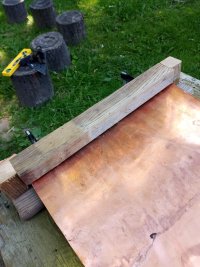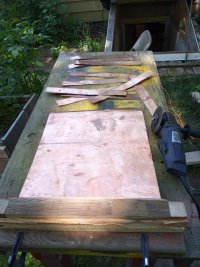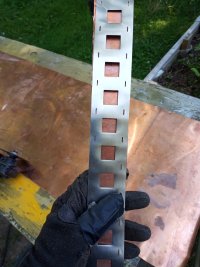harrisonpatm
Member
- Joined
- Jan 5, 2022
- Messages
- 401
I'm working on an EV conversion for a motorcycle and am putting together a 12p24s pack using Battery Hookup's 32650 LiFePO4 cells. I chose these over Lithium Ion for their longer life, higher discharge rates, and thermal stability; if I get in an accident I don't want to risk fireworks. One of the downsides of course is the heavier weight. An issue I face for the pack as a whole is that a motorcycle (or any other EV really) is going to need to discharge high current rates, which makes building the pack with nickel strips an issue. I wanted to share my solution, in case it can help anyone else.
My math is telling me that I should expect 100A discharges on averages, with peaks up to 200A. The cells in 12p can handle that. It was the series connections I was worried about, specifically on the 23 series connections, each of which would need to handle the whole 200 amps. I'm using straight lines of 12 cells for each P group, next to the following 12 cells, and so on. My nickel strips are rated for only about 5 amps each, so even using one strip between each cell, for 12 strips, that capacity is only 60amps. I would need to stack 4 strips between each cell, and that's not very feasible. Luckily I learned, both on this forum and other resources, about copper strips that you can get on AliExpress (like this) which can carry a lot more current. Expensive, though.
I found a giant sheet of copper roofing at my local scrapyard, which I love, got it for 50 bucks. Same amount of copper purchased new would be several hundred dollars. I also like scrapping and reusing rather than buying new (I'm sure others on the site can get behind that). I can also take all my cutoff and sell it back to them for 10 or 20 bucks down the road, or reuse the scraps for other projects.

Used a section of my nickel strip to mark the width I would need, which was about 15.5"

Cut that with an angle grinder to get a long sheet at 15.5" width

Made a simple wooden jig to stick the long sheet in, and cut off the exposed length to get 15.5" strips at just under 2 inches



Made sure they were still matching up to my stencil

So far so good. Now's the part where I really regretted doing this. My plan was to spot weld the 2p nickel strips in place on the batteries, then go back and solder the copper to the nickel, since it's basically impossible to spot weld copper with homebrew equipment. So I would need holes to place solder. I wanted holes at each junction for both the p and s connections between cells, as well as one hold on top of each cell for solder. I figured I could relatively safely solder on top of the cells at this point, since I would actually just be soldering on the nickel, which would also be disappating heat to the copper laid on top. That said, I decided to set myself up to drill 58 holes on each copper strip. For 23 strips, plus extras. One at a time. Yikes! This is the only part that would make me not recommend this method to others. Proceed at your own risk.
Sacrificial 2p nickel to mark my holes

Drilled one, then used it at a stencil for the rest of them. Voila!

After drilling, I put them through a few passes on the wire brush on my bench grinder, which smoothed out the metal shards as welled as removed any tarnish or discoloration, of which there were plenty, what with it being used for roofing. Not perfect I know, but I kept checking the sheets to make sure the holes were still lining up where I wanted them, and they were. This should be a great alternative to solid or stranded copper busbars, because it needs to be relatively compact and fitting in a box. I won't have time to get to assembling the pack for a few days, but I will update how it goes.
Someone want to check my math? The copper is 1.5mm thick, and it's going the whole 15.5 inches across the series connection (394mm), giving me a cross section of 591mm2. It's also on top of those 2p nickel strips, also at 1.5mm thick. I know that other factors are at play, like the holes I drilled not perfectly evenly and the strength of the solder connections, and the fact that it's a long flat cross section rather than something round. But even if you just look at the 591mm2 cross section of copper, that should give me several hundred amps of carrying capacity in the copper alone. Well above my peak usage of 200amps.
Would love to hear some feedback. I havent attached anything yet, so there's time for me to go back to the drawing board. I would only cry a little bit from the time wasted drilling hundreds of holes...
My math is telling me that I should expect 100A discharges on averages, with peaks up to 200A. The cells in 12p can handle that. It was the series connections I was worried about, specifically on the 23 series connections, each of which would need to handle the whole 200 amps. I'm using straight lines of 12 cells for each P group, next to the following 12 cells, and so on. My nickel strips are rated for only about 5 amps each, so even using one strip between each cell, for 12 strips, that capacity is only 60amps. I would need to stack 4 strips between each cell, and that's not very feasible. Luckily I learned, both on this forum and other resources, about copper strips that you can get on AliExpress (like this) which can carry a lot more current. Expensive, though.
I found a giant sheet of copper roofing at my local scrapyard, which I love, got it for 50 bucks. Same amount of copper purchased new would be several hundred dollars. I also like scrapping and reusing rather than buying new (I'm sure others on the site can get behind that). I can also take all my cutoff and sell it back to them for 10 or 20 bucks down the road, or reuse the scraps for other projects.

Used a section of my nickel strip to mark the width I would need, which was about 15.5"

Cut that with an angle grinder to get a long sheet at 15.5" width

Made a simple wooden jig to stick the long sheet in, and cut off the exposed length to get 15.5" strips at just under 2 inches



Made sure they were still matching up to my stencil

So far so good. Now's the part where I really regretted doing this. My plan was to spot weld the 2p nickel strips in place on the batteries, then go back and solder the copper to the nickel, since it's basically impossible to spot weld copper with homebrew equipment. So I would need holes to place solder. I wanted holes at each junction for both the p and s connections between cells, as well as one hold on top of each cell for solder. I figured I could relatively safely solder on top of the cells at this point, since I would actually just be soldering on the nickel, which would also be disappating heat to the copper laid on top. That said, I decided to set myself up to drill 58 holes on each copper strip. For 23 strips, plus extras. One at a time. Yikes! This is the only part that would make me not recommend this method to others. Proceed at your own risk.
Sacrificial 2p nickel to mark my holes

Drilled one, then used it at a stencil for the rest of them. Voila!

After drilling, I put them through a few passes on the wire brush on my bench grinder, which smoothed out the metal shards as welled as removed any tarnish or discoloration, of which there were plenty, what with it being used for roofing. Not perfect I know, but I kept checking the sheets to make sure the holes were still lining up where I wanted them, and they were. This should be a great alternative to solid or stranded copper busbars, because it needs to be relatively compact and fitting in a box. I won't have time to get to assembling the pack for a few days, but I will update how it goes.
Someone want to check my math? The copper is 1.5mm thick, and it's going the whole 15.5 inches across the series connection (394mm), giving me a cross section of 591mm2. It's also on top of those 2p nickel strips, also at 1.5mm thick. I know that other factors are at play, like the holes I drilled not perfectly evenly and the strength of the solder connections, and the fact that it's a long flat cross section rather than something round. But even if you just look at the 591mm2 cross section of copper, that should give me several hundred amps of carrying capacity in the copper alone. Well above my peak usage of 200amps.
Would love to hear some feedback. I havent attached anything yet, so there's time for me to go back to the drawing board. I would only cry a little bit from the time wasted drilling hundreds of holes...




